As everyone in the world knows, China has a great cultural heritage, which attracts people from all over the world to learn about China. With such a long, unbroken history and culture, China's traditional arts have made one of the greatest artistic and cultural contributions to the nation's rich heritage and to mankind. This can be seen even from small day-to-day supplies, such as the Chinese snuff bottle, Chinese brush pen holders and Chinese perfume pouch, which are very famous throughout the world.
The Chinese Snuff Bottle
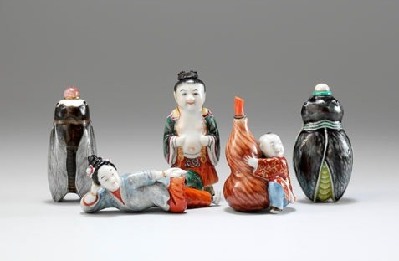
Chinese snuff bottles were at the heart of a fashion that had no equivalent in China's long history. Because of the extraordinary variety of styles, techniques and materials found in these small objects, and the exquisite craftsmanship that was lavished upon them, these miniature masterpieces became one of the most important manifestations of the applied arts during the Qing Dynasty.
At first confined to the elite of the new dynastic house, the popularity of snuff and the snuff bottle was firmly established in and around the court of Beijing by the end of the 17th century. The custom appears to have remained centered there for most of the 18th century, when the use of snuff became a social ritual of the upper class. These containers, upon which so much art, refinement and money had been expended, became the subject of avid acquisition. Snuff bottles also became the new currency for the purchase of favors, positions and advancement in government.
Spreading slowly and gradually to the rest of the country, snuff-taking and the collection of snuff bottles had become a nationwide habit among all social classes by the end of the 18th century. It was common courtesy to offer friends a pinch of snuff upon meeting them in the street or at home, and great status was accrued to the owner of the most unusual or finest bottle.
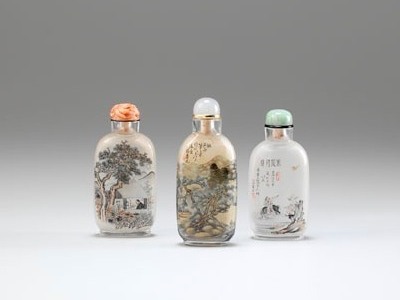
Made in every material known to the Chinese—glass, porcelain, jade and other hard stones, ivory, coral, lacquer, amber, wood, etc—the snuff bottle was then produced in enormous quantities and of varying quality to supply the increased demand. Although the high point in the manufacturing of most types of bottles was the 18th century, a great many fine bottles continued to be made throughout the 19th century.
The popularity of snuff and the snuff bottle rose and fell with the Qing Dynasty. After the revolution and the establishment of the Republic in 1912, the fashion of taking snuff died away. Today, however, there are a rapidly growing number of collectors throughout the world who are fascinated by these small, exquisite objects.
Snuff bottles made of crystal or glass (and, more rarely, other materials such as agate or hair crystal) are painted on the inside using a narrow sliver of bamboo or brush, and ink and color. The earliest recorded inside-painted bottles were produced in the early 19th century, and were recorded as being the work of Gan Xuanwen of the Lingnan School in Guangzhou. The proliferation of inside-painted bottles came with the foundation of the Beijing School in the late 1870s by Zhou Leyuan. Another notable artist of that time was Ding Erzhong, whose work was characterized by his delicate brushstrokes and unprolific output. There are also many other notable artists: Ma Shaoxuan, Chen Zhongsan, Wang Xisan, and Liu Shouben, whose works are famous all over the world.
Chinese Brush Pen Holders
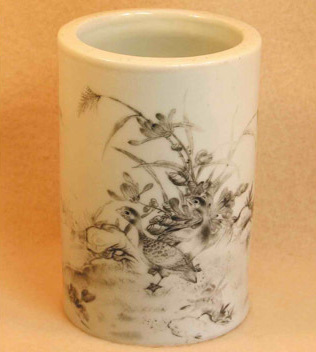
A brush pen holder is a container for holding brush pens when they are not in use. It has been a favorite stationery item of scholars and men of letters since ancient times. Observing its useful and decorative qualities, one can easily see why.
Most brush pen holders are tube-shaped, some with openings like plum bosoms, sunflowers, clouds, book scrolls and irregular octagons. The decorative patterns on the surface are usually paintings featuring some scholars' get-together or a big fish standing on a turtle (symbolizing “the God of Literature and Exams, bringing good luck”). Paintings featuring landscapes, flowers and birds are also used. The following are some beautiful and unique brush pen holders from different dynasties.
Bamboo Carved Pen Holder Featuring a Maid Stealing a Look at a Book Scroll
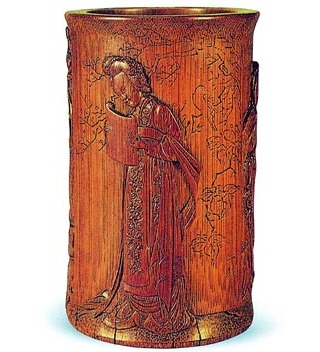
This is the signature work of Zhu Sansong, a renowned bamboo sculptor of the Ming Dynasty. The illustration is a scene from Romance of the West Chamber, a famous Chinese play. The carving skills involve various degrees of depth and elaborateness, producing a multi-layered effect on the whole picture.
Bamboo Carved Pen Holder Featuring Beautiful Ladies
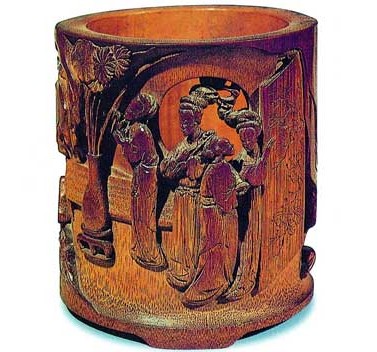
Carved by Zhu Sansong of the Ming Dynasty, this pen holder is a work that combines low relief and high relief carving skills with a shallow carving technique.
Carved Lacquerware Pen Holder Featuring the Painting of Holding a Qin to Visit a Friend
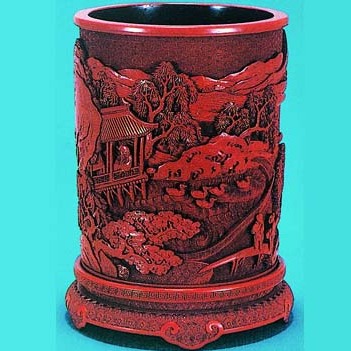
Visiting friends is a common subject of Chinese paintings. The outer surface of the pen holder is engraved with mountains, rivers, pavilions, towers, human figures and trees. On the small bridge, there's a young servant holding a qin (a seven-stringed plucked instrument in some ways similar to the zither) among other passersby. The subject of the painting is visiting a friend with a qin.
Brush-Holder with Figures
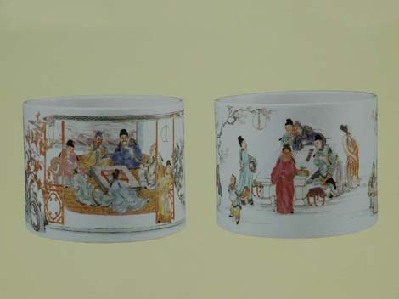
The brush-holder has a circular mouth, an upright body, and a flat base. Simple and elegant, it is made of refined white clay with a pure, smooth glaze. The scene painted on its surface is of a dinner party held on a spring evening, depicting the life of Li Bai, the great poet of the Tang Dynasty, and his friends. All the figures, rockeries, trees and flowers were outlined first and then filled with soft colors. A six-character inscription in regular script circled with blue lines can be seen inside the ring-shaped base, reading “Made during the Yongzheng Reign of the Qing Dynasty”.
Chinese Perfume Pouch
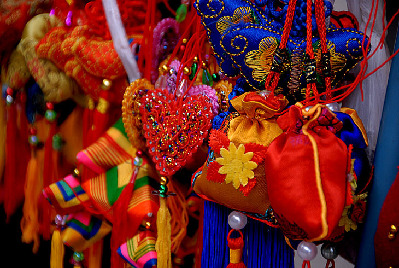
The history of the Chinese perfume pouch (commonly called Xiangbao, Xiangnang, Xiangdai or Hebao) can be traced back to the Duanwu Festival, or Dragon Boat Festival, which falls on the 5th day of the 5th lunar month. It is said that people in ancient times used to carry a medicine bag while hunting, to drive out poisonous insects. Today we still see some old men carry on them a bag in the shape of calabash, a custom that can probably be traced back to this old tradition.
Another old saying goes that when Qu Yuan, the great poet of the Chu state during the Warring States Period, drowned himself in Miluo River on the 5th day of the 5th lunar month, people in the neighboring Qin, out of sympathy for him and to cherish his memory, made and carried a pouch stuffed with sweet grass and perfumes that he had loved.
Some people say carrying the pouch was a long-standing custom of the Han people; its origin can be traced back to the Tang Dynasty, when women in the rural areas would in the 4th lunar month each year begin to make perfume pouch with colored silk, silk threads and gold and silver beads. By the Qing Dynasty, perfume pouch was carried by people not only on the Dragon Boat Festival, but every day, because the Manchus had long had that custom. According to the a Qing Dynasty custom, emperors and empresses were required to carry perfume pouch on them all year round and at the end of every year, or on important festivals, the emperor would award the princes and ministers each a perfume pouch to show his favor for them. More interestingly, perfume pouches were used by Emperor Tongzhi and Emperor Guangxu to choose their empresses: the girls would line up to be examined by the Emperor, who would hang a perfume pouch on the button on the dress of the girl to whom he took a fancy.
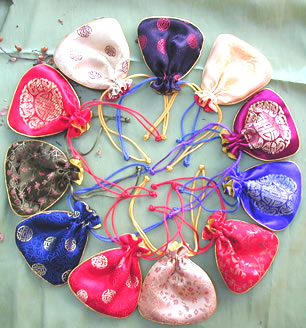
Common people make an even more extensive use of the perfume pouch. Men and women, old and young all can carry one on them and present it to others as a gift. There are many descriptions of this practice in the Chinese classic novel A Dream of Red Mansions. Some young men and women often use it as a token of love. There is a Yu opera, Story of a Perfume Pouch, which tells the story of a married couple who have been separated and have heard no news of each other for years but one day finally come together and are reunited—with the help of a perfume pouch.
Of course, as the development of human society and the advance of science march forever forward, the perfume pouch loses some of its original functions. But it remains in the favor of many. It takes a wide variety of shapes, but whatever shape it takes is always small and exquisite and has a pleasing fragrance. It not only is a delicate work of art, but also has some preventive power against diseases. Among young people in the countryside, it is still a valued gift to be exchanged between lovers. Decorations range from floral and small animals (such as birds and fish) designs to patterns of musical instruments, books, utensils and romantic figures, depending on the maker's aesthetic taste.
(Chinaculture.org February 22, 2011)
Go to Forum >>0 Comments